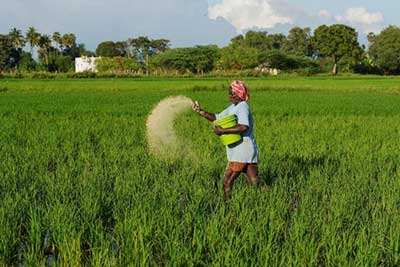Date : 19/12/2023
Relevance: GS Paper 3 – Indian Economy
Keywords: ToT, GVA, NITI AYOG, MSP
Context-
The terms of trade (ToT) for Indian agriculture, as indicated by the movement in prices of farm commodities relative to non-farm goods and services, have experienced noteworthy changes over the past fifteen years. This analysis draws upon national income statistics, particularly Gross Value Added (GVA) at current and constant prices, and employs implicit price deflators to calculate ToT. The ToT for agriculture relative to the non-agriculture sector has exhibited a remarkable improvement, with significant implications for the agricultural sector and the broader economy.
Historical Perspective:
NITI Aayog member Ramesh Chand and consultant Jaspal Singh's research reveals that the ToT for agriculture saw a decline from 90.2 in 1973-74 to 72.2 by 1985-96. Subsequently, until the mid-2000s, there was limited recovery, reaching levels of 85. However, a substantial turnaround occurred from 2009-10 onwards, culminating in a peak ToT of 130.2 in 2020-21, slightly easing to 126.6 in 2022-23.
Factors Influencing ToT:
The surge in India's agricultural growth rate, averaging 3.7% per annum from 2005-06 to 2021-22, is attributed to the improved ToT for the sector. This improvement can be traced back to the global agri-commodity price boom from 2004 to 2014 and policy interventions, especially minimum support price (MSP) hikes for crops, implemented by both the United Progressive Alliance and the National Democratic Alliance governments.
Calculation of ToT:
To calculate ToT, implicit price deflators are utilized by comparing GVA at current prices to GVA at constant prices. By dividing the deflator for agriculture GVA by that for non-agriculture GVA, the ToT for the farm sector in a given year can be determined. The real recovery in ToT for agriculture is instrumental in understanding its impact on farmers and agricultural laborers.
Implications for Farmers and Agricultural Laborers:
While ToT based on implicit price deflators offers a broad perspective on the movement of agricultural commodity prices relative to non-agricultural goods and services, it does not explicitly depict how these changes affect those directly engaged in crop production. The Agriculture Ministry's data on prices received and prices paid by farmers provide a more nuanced view.
The Ministry's indices for prices received (IPR) and prices paid (IPP) serve as the basis for calculating the ToT for farmers. A ratio above one implies favorable pricing power for farmers, while a ratio below one indicates unfavorable conditions. The results show a significant increase in the farmers' ToT ratio between 2004-05 and 2010-11, but subsequent years have seen stagnation or a decline, indicating challenges for the farming community.
Comparatively, agricultural laborers experienced a more substantial rise in their ToT ratio, reflecting increased real wages. This was driven by accelerated economic growth, new employment opportunities outside agriculture, and government interventions like the Mahatma Gandhi National Rural Employment Guarantee Act. However, even for agricultural laborers, the ToT ratio has witnessed a decline after 2018-19, impacting rural wages.
Political Economy Implications:
The evolving ToT has profound implications for the political economy, particularly concerning the socioeconomic dynamics of farmers and agricultural laborers. Agricultural laborers, often from marginalized backgrounds, historically occupied the lowest rung of India's social ladder. The accelerated growth from 2003-04 created alternative employment avenues for them outside agriculture, leading to a rise in real wages.
The ToT analysis reveals a tightening of labor markets, providing laborers with alternatives beyond traditional agricultural activities. This, coupled with government interventions, has led to a significant increase in real wages for agricultural laborers, impacting farmers who face higher production costs without a commensurate increase in produce prices.
The stagnation in the ToT for farmers over the last decade, despite subsidies and MSP procurement, highlights the challenges faced by the farming community. Factors such as rising production costs, lack of significant crop yield breakthroughs, and landholding fragmentation contribute to this stagnation. The implications are evident in the demands for reservations in government jobs and educational institutions by dominant agrarian communities.
Conclusion
In conclusion, the transformation in India's agricultural terms of trade over the last decade and a half has been substantial, with positive implications for the sector's growth. The improvement in ToT, driven by global agri-commodity price trends and policy interventions, has played a pivotal role in enhancing the agricultural growth rate.
However, a nuanced examination of ToT for farmers and agricultural laborers reveals divergent trends. While the ToT for the farm sector as a whole has improved, it has been more pronounced for agricultural laborers than for farmers. The last few years have seen stagnation or deterioration in ToT for both, reflecting the complex challenges faced by the agricultural community.
The political economy implications underscore the need for comprehensive policies that address the concerns of both farmers and agricultural laborers. As India strives for inclusive and sustainable growth, understanding and addressing the dynamics of agricultural terms of trade is crucial for shaping policies that benefit all stakeholders in the agricultural sector.
Probable Questions for UPSC mains Exam-
- Explain the factors influencing the recent transformation in India's Agricultural Terms of Trade (ToT). Evaluate the role of minimum support price (MSP) hikes and global agri-commodity price trends in shaping the ToT for the agricultural sector.(10 marks, 150 words)
- Analyze the trends in the Terms of Trade (ToT) for farmers and agricultural laborers in India. Identify the reasons for the stagnation or decline in ToT for both groups in recent years and discuss the political economy implications. Propose policy measures for inclusive and sustainable growth in the agricultural sector. (15 marks, 250 words)
Source- Indian Express







